Table of Contents
Introduction
Arabic front hand mehndi designs have captured the hearts of young Indian mehndi enthusiasts with their elegant simplicity and bold artistry. Unlike the intricate full-hand designs common in Indian bridal mehndi, the Arabic style for the front of the hand emphasizes expansive negative space and striking, well-defined motifs. Typically, these designs feature large floral patterns, often dominated by roses, and flowing vines that gracefully extend across the palm. The result is an artistic expression that not only beautifies the skin but also resonates with cultural traditions of both Middle Eastern and South Asian celebrations.
I remember how a friend’s front-hand design, with its bold rose and airy lines, sparked our conversation about creativity and tradition. This style is not only quick to apply but also allows for a modern, minimalistic look that works well with casual gatherings, festivals, and weddings. In this article, you will learn about the unique characteristics of Arabic front-hand mehndi designs, explore current trends and motifs, and get step-by-step instructions to achieve a flawless application. Whether you’re a beginner or have some experience, these tips and techniques will help you create a design that’s both culturally rich and uniquely yours.

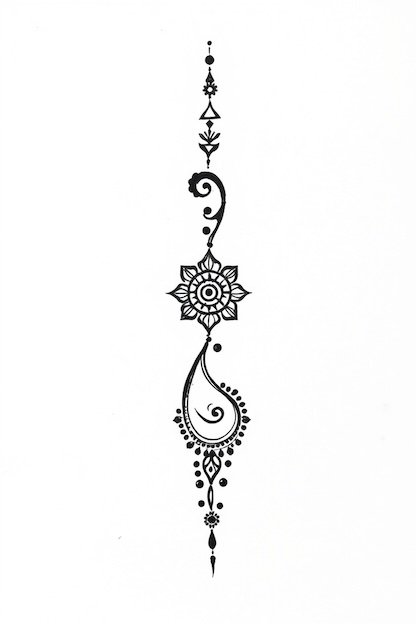
If you’re interested in other mehndi options then check out our articles on Arabic Back Hand Mehndi Designs and Arabic Rose Mehndi Designs. For a high level overview see our article on Arabic Mehndi Designs.
Background & Key Characteristics
Arabic front hand mehndi designs stand out for their clean, bold lines and ample use of negative space. Unlike the densely decorated Indian styles, Arabic designs on the palm focus on a few powerful motifs, typically large roses, paisleys, or mandala patterns, that are outlined in thick, confident strokes. This approach highlights the natural beauty of the skin and creates a striking contrast between the henna and the untouched areas.
One of the hallmarks of this style is its asymmetry. Rather than mirroring the design on both hands, Arabic front-hand patterns often feature a diagonal flow or an off-center placement that gives the design a dynamic, modern feel. The emphasis on open space not only makes the design look clean and uncluttered but also ensures that the bold motifs are the focal points. This style is especially popular among young brides and festival-goers who appreciate a design that is both trendy and rooted in tradition.
These key characteristics, bold outlines, strategic empty areas, and a focus on one or two standout elements, make Arabic front hand mehndi designs a favorite for those looking to express their individuality while honoring a rich cultural heritage.
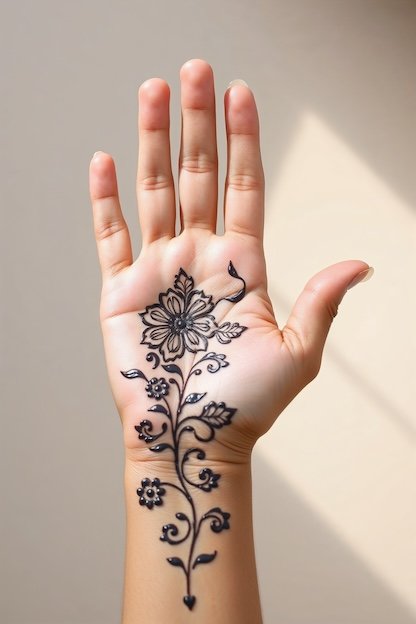

Design Elements & Techniques
Creating Arabic front hand mehndi designs involves a blend of artistic intuition and precise technique. The style is characterized by several key design elements:
Floral Motifs: Large, bold flowers, particularly roses, are a signature element. Drawn with thick, fluid lines, these floral motifs serve as the centerpiece of the design. The rose, with its layered petals and curving lines, not only adds beauty but also symbolizes love and new beginnings—a popular choice for weddings and festive occasions.
Flowing Vines and Paisleys: Connecting the main floral element are elegant vines and paisleys. These lines are drawn in sweeping, curved strokes that extend naturally across the palm. The paisley, reminiscent of a teardrop or mango shape, adds a distinctive touch that is both traditional and stylish. In Arabic front-hand designs, these elements are deliberately spaced out to maintain an airy look.
Negative Space: Unlike densely filled patterns, Arabic designs make ample use of the skin’s natural tone. This negative space is as crucial as the henna itself, emphasizing the bold outlines and allowing each motif to stand out. The sparing use of detail contributes to the modern, minimalistic appeal of the design.
Geometric and Net Patterns: Some contemporary artists incorporate subtle geometric accents such as fine lattices or chevron patterns that nod to Middle Eastern architectural influences. These additions offer texture without overwhelming the overall simplicity of the design.
Below are several Arabic Front Hand Mehndi designs for the front of your hand from our gallery. More designs are included throughout this article for you. Click on the images to expand and print.



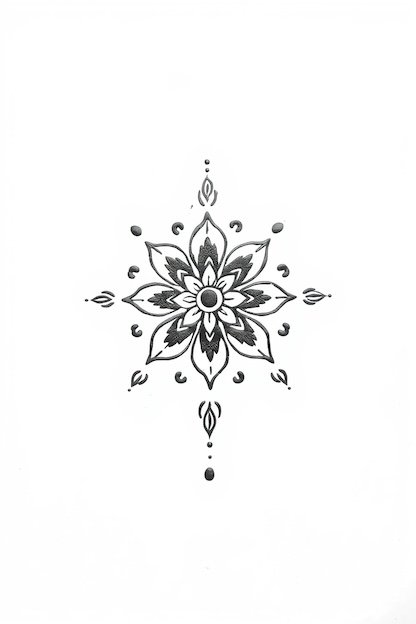
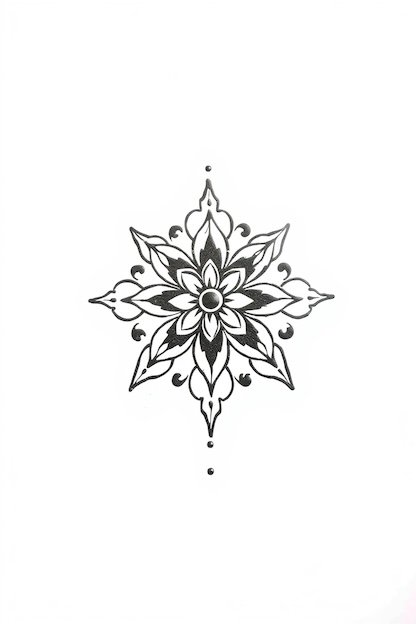
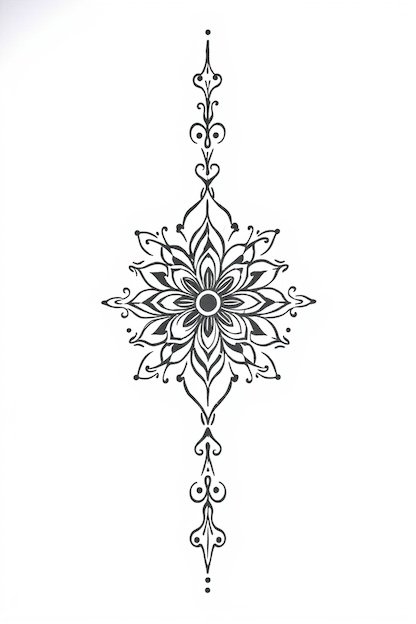

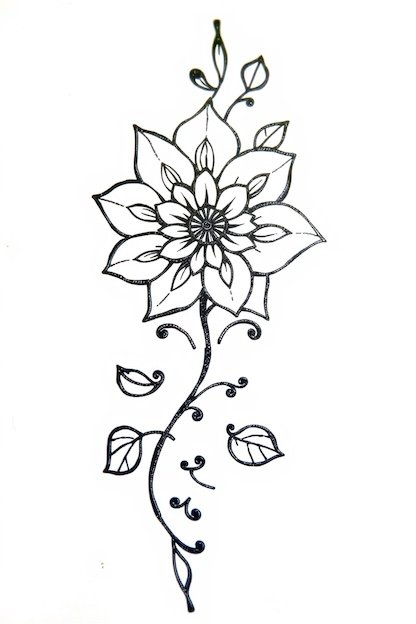
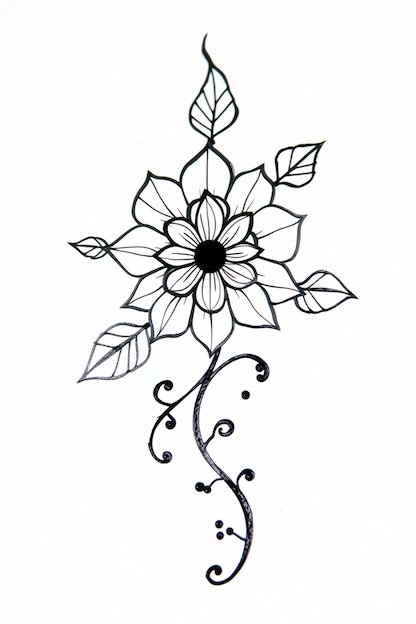
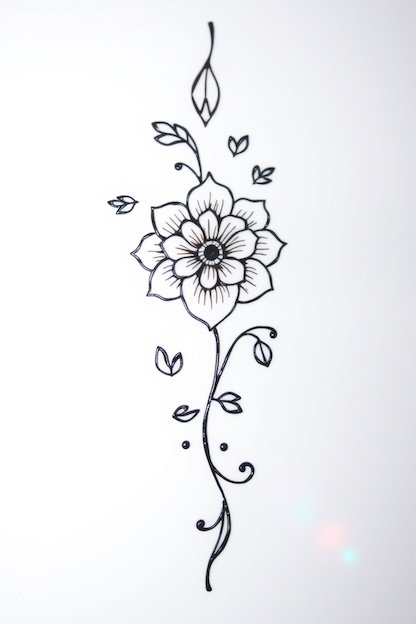
Techniques for Achieving a Perfect Design
Steady Hand and Controlled Pressure: A smooth, continuous flow is important. Hold the henna cone like a pen and practice gentle, even pressure to ensure consistent lines. This control is particularly important on the front hand where curves must blend naturally.
Mapping the Layout: Start by sketching the major outlines lightly. Many artists prefer to begin at the center of the palm with the main motif and then extend the vines diagonally toward the fingers. This method not only creates a balanced composition but also prevents accidental smudging on the palm.
Layering Detail: Once the primary motifs are in place, add secondary elements like tiny dots, delicate leaf shapes, or minimal net patterns. Avoid overfilling; the essence of Arabic front-hand mehndi lies in its simplicity and the interplay between henna and untouched skin.
Practice and Patience: Like any art form, proficiency comes with practice. Try drawing the design on paper or a practice sheet before transferring it to the hand. With time, you will develop muscle memory and a natural flow that makes each design uniquely yours.
These techniques ensure that your Arabic front-hand design remains both visually striking and elegantly simple. The goal is to celebrate the bold elements while keeping the overall look fresh and uncluttered.

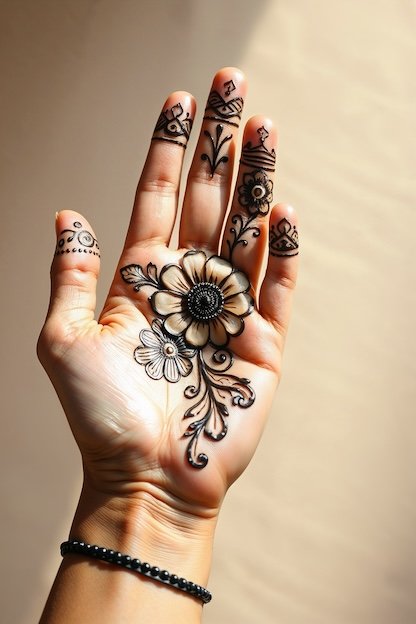
Step-by-Step Tutorial or Application Guide
Follow this comprehensive guide to create a beautiful Arabic front-hand mehndi design, tailored specifically for the palm side.
1. Preparation
Clean Your Hand: Start by washing your hand thoroughly to remove oils and lotions. Dry it completely to ensure the henna adheres well.
Gather Materials: Use a high-quality, natural henna cone. Ensure you have tissues for wiping excess paste, and keep your workspace well-lit and comfortable.
2. Sketching the Main Motif
Outline the Focal Point: Begin by drawing the main motif in the center of the palm. A large rose or a mandala-inspired design works beautifully. Use confident, bold strokes with your henna cone. This central element should occupy a significant portion of the palm without overwhelming it.
Plan the Layout: Visualize how the design will flow from the center toward the edges of the palm. Lightly map out where the connecting vines and additional motifs will be placed. A well-planned layout helps maintain balance and symmetry.
3. Extending the Design
Create Flowing Vines: From the main motif, draw one or two elegant vines that extend diagonally toward the fingertips. These vines should curve naturally, giving a sense of movement. Remember, the goal is to lead the eye from the center outwards.
Add Secondary Motifs: Along the vines, intermittently add smaller elements like paisleys or mini-roses. Space these out generously to preserve negative space. For example, after the central rose, add a small paisley two centimeters away, then another tiny flower further along the vine.
4. Detailing and Refinement
Incorporate Fine Details: Once the major outlines are complete, add fine details such as dot clusters or delicate leaf patterns. These should be applied sparingly, ensuring that the bold outlines remain the primary focus.
Check for Balance: Step back and assess the overall design. Make sure there is a harmonious balance between filled areas and empty spaces. Adjust by adding or omitting minor details to achieve a neat look.
Avoid Overcrowding: Remember that Arabic front-hand designs thrive on simplicity. Resist the temptation to overfill; sometimes less is more. A few well-placed accents are more effective than a crowded pattern.
5. Drying and Aftercare
Allow the Henna to Set: Let the henna paste dry naturally on your palm for 20–30 minutes. Avoid moving your hand during this period to prevent smudging.
Seal the Design (Optional): If you wish to enhance the stain, lightly dab a lemon-sugar solution over the design once it is semi-dry. This traditional method helps the henna adhere better and deepens the color.
Leave the Paste On: For a richer stain, keep the henna on your hand for at least 3–4 hours. Many artists choose to leave it on overnight. Once you’re ready, gently scrape off the dried paste with a tissue or your finger; do not wash it with water immediately.
Moisturize: After the paste is removed, applying a light coat of natural oil (like coconut or mustard oil) can help preserve the design. This not only deepens the stain over the next day or two but also protects the design from premature fading.
Following these steps will help you create a refined, professional-looking Arabic front-hand mehndi design. With practice and patience, your technique will improve, making each new design a celebration of creativity and cultural artistry.
Below are more Arabic Front Hand Mehndi designs from our gallery. More designs are included throughout this article for you. Click on the images to expand and print.

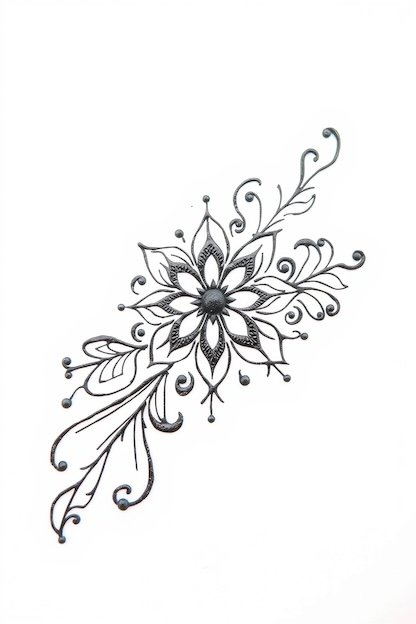
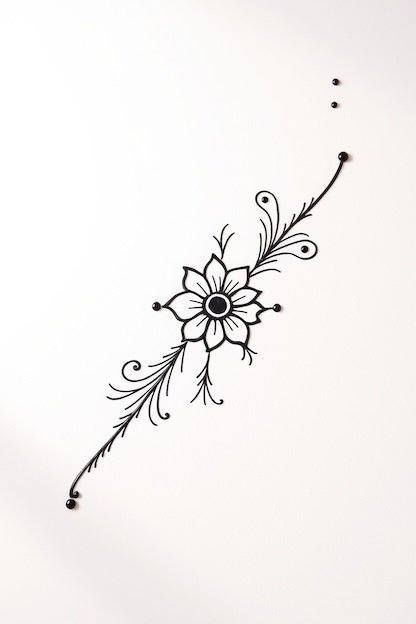
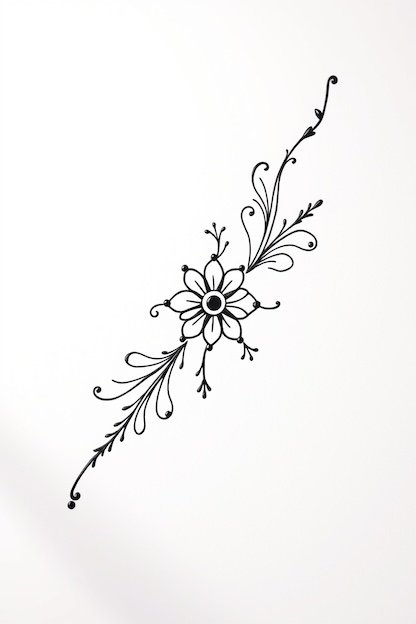
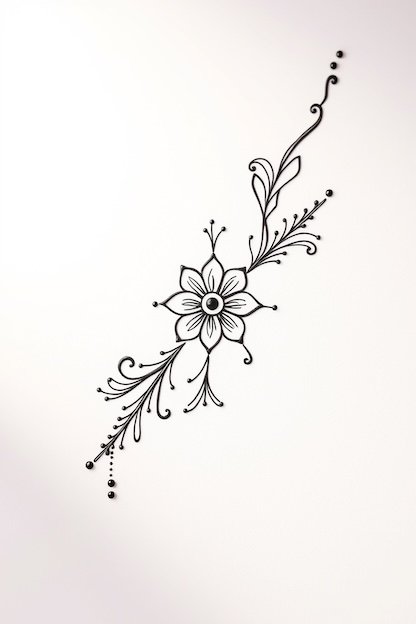
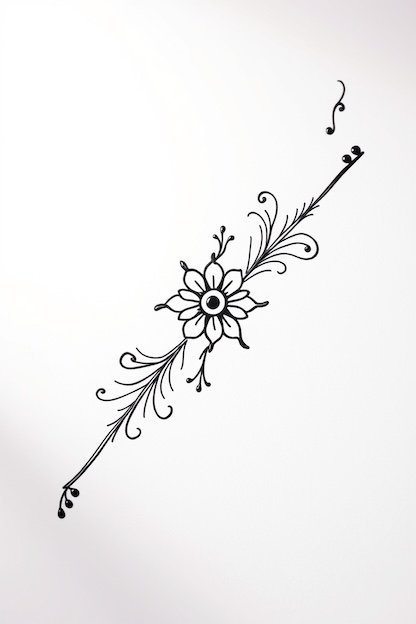
Variations or Popular Trends
Arabic front hand mehndi designs have evolved while staying true to their core elements. Here are some exciting variations and emerging trends:
| Trend | Description |
|---|---|
| Minimalist Layouts | Many modern artists are embracing minimalism. In these designs, a single, large rose or a mandala is the centerpiece, accompanied by a few strategic vines. This approach leaves significant negative space, emphasizing the elegance of the bold motifs. |
| Indo-Arabic Fusion | A growing trend is to blend Arabic minimalism with subtle Indian detailing. For example, the strong outlines of a traditional Arabic design might be softly interwoven with fine dot work or delicate filigree often seen in Indian mehndi. This fusion creates a hybrid design that appeals to lovers of both styles. |
| Geometric Accents | Influences from Moroccan and Gulf styles have introduced geometric patterns into Arabic designs. Some artists now incorporate simple grids, chevron patterns, or diamond shapes alongside floral elements. These geometric accents add a contemporary twist without compromising the overall simplicity. |
| Bold and Bright with White Henna | Experimental designs sometimes feature white henna or glitter overlays. White henna is used sparingly to create intricate details on a bold dark background, while glitter highlights specific areas such as the center of a rose. This trend offers a fresh, high-fashion look perfect for festive occasions. |
| Customized Personalization | Personalization is key. Some designs now include tiny initials or personalized symbols discreetly integrated within the pattern. This makes the design uniquely yours, resonating with the trend of self-expression among young individuals. |
Each of these trends adapts traditional Arabic front-hand mehndi principles to modern aesthetics. Whether you lean toward minimalism or fusion styles, the beauty of these designs lies in their ability to be both timeless and innovative.

Cultural Inspirations & Symbolism
Arabic front hand mehndi designs carry deep cultural and symbolic meanings that enhance their beauty. At the heart of these designs is the rose, a universal symbol of love and new beginnings. In many Middle Eastern traditions, the rose is associated with romance, while in South Asia, it is a marker of auspiciousness and beauty.
The strategic use of negative space in these designs is not just an aesthetic choice—it reflects clarity and purity. Leaving parts of the palm unadorned creates a striking contrast that emphasizes the bold elements, mirroring the idea of balance in life. In many cultural ceremonies, particularly weddings and festivals like Eid and Diwali, mehndi is seen as a blessing that brings luck and protection. I’ve observed that when friends see a well-executed Arabic design on the front hand, they admire not just the art but also the cultural pride it represents.
This art form, steeped in history, is a testament to the enduring connection between tradition and modernity. It unites communities and generations by celebrating beauty, love, and prosperity through every intricate line.
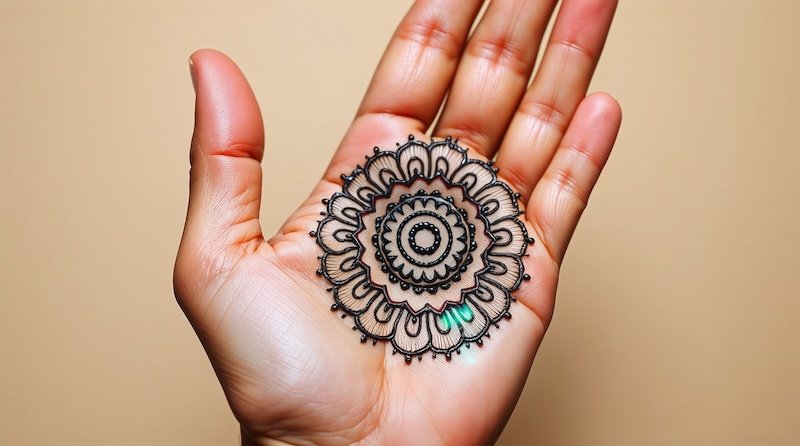
Creative Customization & Future Trends
Personalization and innovation continue to shape the future of Arabic front-hand mehndi designs. Today’s artists encourage experimentation with traditional motifs while adding contemporary touches that speak to individual style. One popular customization is the subtle incorporation of personalized symbols. This could be a favorite number, initial, or a small emblem that carries personal meaning. Such details can transform a standard design into a unique piece of body art that tells a story.
Innovative techniques are also emerging. For instance, some artists are experimenting with varying henna application pressure to create gradient effects within the same design, giving a multi-tonal finish. Although this requires practice, it adds depth and a modern touch to the traditional Arabic style. Minimalist designs, featuring one large, striking motif on the palm and sparse supporting elements, are particularly popular among young professionals and brides seeking an elegant yet understated look.
The influence of social media cannot be understated—platforms like Instagram and Pinterest inspire artists to try new ideas, share tutorials, and collaborate on fusion designs that blend Arabic techniques with global trends. As the art form evolves, expect to see more creative crossovers, such as integrating fine geometric lines or even experimenting with non-traditional colors. These innovations not only honor the rich heritage of Arabic mehndi but also ensure that the art continues to resonate with modern aesthetics and personal expression.
FAQs or Common Misconceptions
Q: Are Arabic front hand mehndi designs easier to apply than other styles?
A: Yes, its emphasis on bold, clear motifs and ample negative space makes it more forgiving for beginners.
Q: How long should the henna paste remain on for a rich stain?
A: For a deep, lasting stain, leave the paste on for 3–4 hours, or even overnight if possible.
Q: Can I blend Arabic front hand mehndi designs with Indian styles?
A: Absolutely. Many modern artists incorporate subtle Indian detailing into Arabic designs, but ensure the core Arabic elements remain prominent.
Q: What common mistakes should I avoid?
A: Avoid overloading the design with details, using low-quality henna, or disturbing the paste before it sets. Stick to bold outlines and allow plenty of time for the paste to dry.
Conclusion
Arabic front-hand mehndi designs offer an elegant blend of tradition and modernity. Their bold floral motifs, generous negative space, and distinctive asymmetric layouts create a look that is both timeless and fresh. This guide has walked you through the unique characteristics, current trends, and step-by-step techniques tailored for the front hand. Whether you’re preparing for a wedding, a festive celebration, or simply expressing your personal style, these designs serve as a creative canvas that connects you to rich cultural traditions. Embrace the simplicity and artistry of Arabic mehndi, and let your hands become a beautiful expression of heritage and individuality.

